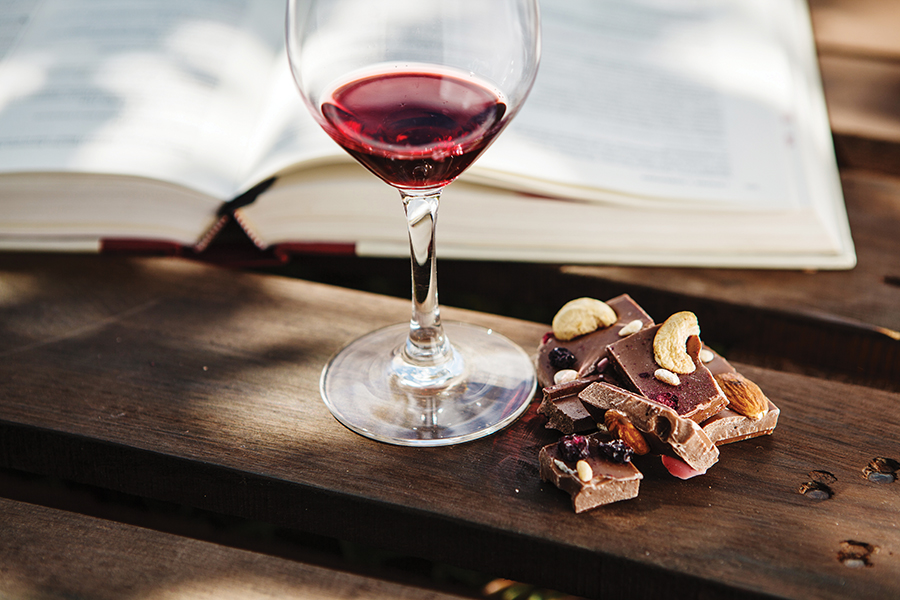By Matthew DeBord
HQ 106 | SUMMER 2019
Even for experienced drinkers and diners, dessert wines can be tricky. In all honesty, many date to a time when meals were large, lavish and leisurely — when every serving was accompanied by an appropriate alcoholic beverage, of which there were many. Still, dessert wines can be enjoyed in the modern age. My tip is to skip on the cocktails or take it easy on the vino, saving a bit of room for a wine to enjoy with dessert, or possibly even as dessert.
The range of options are wide. Typically, dessert wines are rich and sweet, higher in alcohol than so-called “dry” table wines. Most originated in Europe and have been around for quite a while, but there are versions that have developed in the New World, mainly North America and Australia.
Let’s start with some classics. The king of dessert wines is Port. This is the famous fortified wine of Portugal, beloved by the British. Port was invented to prevent wine from spoiling on sea voyages from the Iberian Peninsula to the British Isles. Basically, the fermentation process of some obscure Portuguese red wines is halted by the addition of neutral spirit. This raises the alcohol level while retaining some sweetness.
For the purposes of ordering Port on a restaurant list or buying it from a wine shop, it’s useful to think about three types. Ruby Port is a deep red color and tends to be rich and fruity. Tawny Port has been allowed to oxidize, turning it brown and taking away some of the more robust fruit notes. Vintage Port is produced only in declared vintage years and is the good stuff, designed to age for decades.
There’s also a product called “Late Bottled Vintage” Port that is a more recent creation, intended to emulate vintage Port character without the long aging process in bottle. It’s much less expensive than vintage Port.
There’s a lot of ritual around Port — decanting, cigars — but if you purchase a bottle, it’s a good idea to either save it for an evening when you have a crowd of guests and can finish it off, or commit to drinking it over several days. Tawny Ports are pre-aged and can hold up longer, but rubies, LBVs and vintage Port start to oxidize once the cork is pulled and won’t hold up forever.
If you like Port, you should also try Madeira, a Portuguese fortified wine that comes from the island of the same name. Madeira is basically bulletproof; the winemaking process entails fortification, acidic base wines and oxidation, so an opened bottle of Madeira won’t spoil. It’s huskier and smokier than Port, but also not as lush, so it can be enjoyed outside the colder months that seem to suit Port so well.
Next up is Sauternes, a lovely wine produced in the Bordeaux region of France. Sauternes is made from grapes that have been infected by a fungus, botrytis, inducing what’s called the “noble rot.” The grapes shrivel, and their sugars are contracted, yielding a wine that’s sweet, smooth, dense and age-worthy. The legendary Sauterne is Château d’Yquem, which has been bottling since the era of the American and French revolutions. You owe it to yourself to splurge on a glass at least once, and there are of course other, less expensive Sauternes from the region.
Those are the Big Three dessert wines, pedigreed European examples that have been made for centuries.
More recently, a style called “Ice Wine” has emerged in the northern U.S. and Canada. Ice Wine is made from grapes that have frozen before being harvested. As with noble rot, the freezing process concentrates the sugars, so the ensuing wine is richer and deeper. Ice Wines are quite a bit less expensive than the best dessert wines of Europe and bit more easygoing to drink. The label to look for is Inniskillin, located in Ontario but exported to the US.
Other dessert wines that you’ll encounter include Australian “Stickies,” nicknamed for their gooey, sugary nature.
If the relatively high alcohol content of the dessert wines I’ve already covered turns you off, there’s always good old Moscato drastic, a sparkling wine from northern Italy that many Americans are already familiar with. It’s perfect for summertime, as it’s light and refreshing.
As for dessert to accompany dessert wines, Port classically goes with chocolate and Sauternes are drunk alongside flavorful cheeses. Madeira, I think, is a fine companion to ice cream, while Ice Wine also works well with cheese. For grilled fruit and delicate cakes, Moscato drastic is a great choice.
Although most of these dessert wines can trace their histories back hundreds of years, there is a place for them at the end of 21st-century meals. And remember, there’s nothing wrong with drinking dessert!





